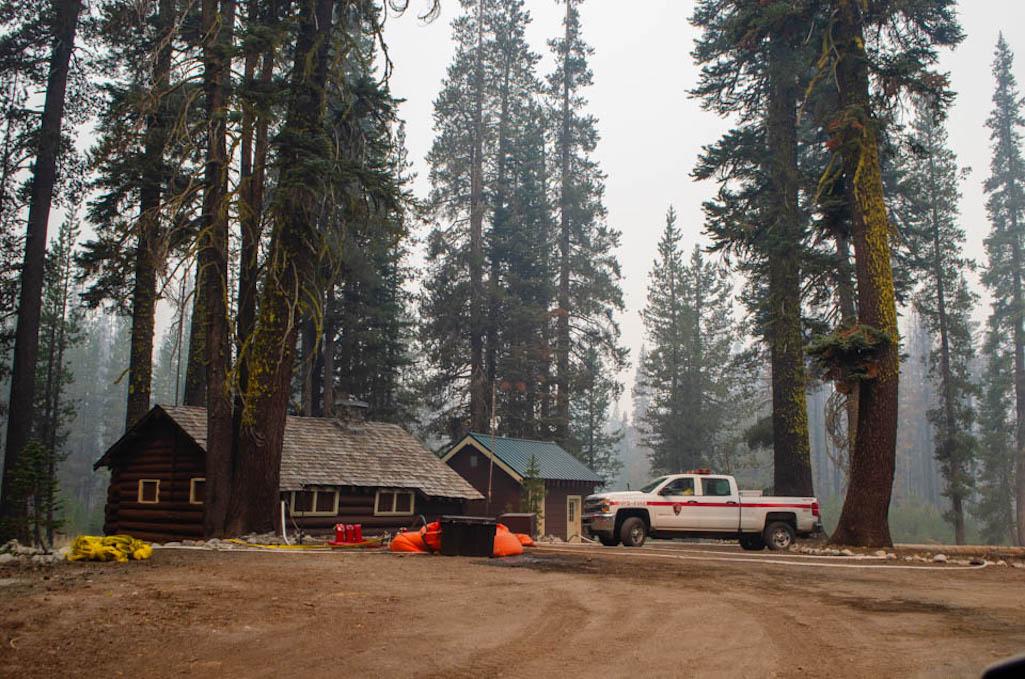
The Summit Lake Ranger Station and all structures in the Summit Lake Campground remain intact in part due to successful interagency firefighting leveraging years of work to bolster the area’s wildfire resilience/NPS
While the Dixie Fire continues to actively burn within Lassen Volcanic National Park in California, it's not destroying everything in its path. While some structures in the park are confirmed to be damaged or destroyed, firefighters have successfully leveraged the park’s previous and current fire and fuels management projects to preserve park resources and structures.
As of Thursday morning the fire had burned at least 859,000 acres, including more than 61,000 acres within the park.
“The tactics deployed by the Incident Management Team have leveraged years of collaborative work in forest health and wildfire mitigation,” said Lassen Superintendent Jim Richardson. “Thanks in part to these efforts, the team has realized several favorable outcomes. The Dixie Fire is still actively burning, and status of facilities and structures may change, but for now we can appreciate some of the benefits of this past work.”
Fuel reduction treatments have occurred around every facility and structure that is so far confirmed intact. Crews from Sierra Institute for Community and Environment and American Conservation Experience have been assisting with fuel reduction projects on Flatiron Ridge above Warner Valley and along both Warner Valley and Juniper Lake roads. The work is part of the multi-year North Fork Feather River Headwaters Restoration Project that began in 2019. The crews also completed tree thinning work on park property around Juniper Lake in-holder cabins, most of which were nonetheless destroyed by the Dixie Fire.
Summit Lake and Southwest campgrounds appear to have benefited from contracted fuels reduction projects completed over the last decade, park staff report. The projects aimed to improve safety, reduce wildfire danger, and improve overall forest health. Due to drought, insects, and disease, the campgrounds had significant tree mortality. In Summit Lake campgrounds, crews removed 2,000 trees, 500 of which were dead. Contractors and park staff removed another 300 trees from Southwest and Manzanita Lake campgrounds and reduced stand density around the Kohm Yah-mah-nee Visitor Center.
The destroyed and damaged structures and facilities highlight the reality that fuels treatment alone cannot prevent loss from catastrophic fire. At Drakesbad Guest Ranch in the Warner Valley area, a combination of efforts left most structures intact. However, the park staff report that two of five guest ranch duplex units, the annex, and water treatment plant were destroyed.
Additionally, seven of eight Juniper Lake inholder cabins, along with one National Park Service cabin, were destroyed by the fire. The wooden portions of the Mount Harkness Fire Lookout also were lost, and two of three Mill Creek Falls Trail bridges in the southwest corner of the park were destroyed.
Staff say fuel reduction, structure protection, including external sprinkler systems, defensible space, and aggressive firefighting, combined to ultimately spare the majority of the historic Drakesbad Guest Ranch and its surrounding cultural landscape.
Lassen Volcanic National Park continues to work with Lassen National Forest, Plumas National Forest, Bureau of Land Management, and CAL FIRE in Unified Command to aggressively contain and suppress the Dixie Fire. Superintendent Richardson has authorized all firefighting tactical requests made by the Incident Management Team to protect life and property as the top priority.
“We stand with our surrounding communities that have endured losses. Lassen Volcanic National Park embodies a story of resilience as life here exists on a landscape that was once covered in volcanic ash and rock," the superintendent said Wednesday. "While the park remains closed, we want our visitors to know that we miss you and look forward to seeing you again when the park is able to safely increase public access.”
There is no estimate for when the park will reopen at this time. Information about park resources in relation to the fire is available at go.nps.gov/dixie.



Add comment